Tags
Albi, Assumption of Mary, Black Madonna, Bridan, Cap D'Agde, Chartres, Dordogne, Honore de Balzac, Jean Moulin, Lascaux, Les Eyzies-de-Tayac, National Museum of Pre-history, Nazi, Notre-Dame de Chartres Cathedral, Oradour-Sur-Glane, Our Lady of the Pillar, Rocamadour, Sarlat-la-Caneda, St. Amadour, Toulouse-Lautrec, troglodyte
We finally figured out how to send a link to our blog, 1700Somewhere, rather than the whole post in an email. Click the link to see our latest post. Let us know if this method causes problems.
Our First Taste of France
I’m writing this from an apartment in Barcelona. We’ll catch you up eventually, but we’ve just gone through a stretch of very spotty internet, so we have a way to go.
After Amsterdam, we took the TGV high-speed train to Paris. This let us get a good look at the countryside between cities, though the view was often obstructed by walls, or because the tracks are set in deep furrows.
In Paris, we picked up a rental car. (It costs less to pick up and return the car within one country, driving only in that one country.) Our original plan was to spend that week visiting various places in Normandy, then working our way south. However, we discovered that a massive international equestrian event — with half-a-million extra people! — was taking place in Normandy then, so we had to change our plans.
So we headed south from Paris, then had to fly back to Paris, where we had an AirBnB apartment reserved for a week. After that, we had our week exploring Normandy. This post will get us as far as our return to Paris.
Click on an image to see it larger, then click your back button to return to the blog. All photos (c) Charlie Sawyer.
Chartres was our first stop in France.

Beautiful flowers and gardens abound in Chartres. This is true almost everywhere we’ve been in Europe so far. They are planted and maintained both by the people and by their local governments in town squares, in medians, and along roadsides.

Chartres, like virtually every town in France, has created monuments to memorialize those who suffered and died in both World Wars. One moving monument honors the hundreds of Chartres civilians who were killed in WWII. The name of each victim is engraved on this wall. For Europe, these were not foreign wars, but local ones.

The memorial for Jean Moulin, the most famous hero and martyr of the French Resistance. The sword is held defiantly, but broken. The Resistance did what they could against the Nazis, but every attack or act of sabotage brought on brutal retaliation. The Nazis began killing 10 innocents for every German killed or wounded by Resistance attacks. Later they upped the ante to 100 people, randomly rounded up from the population. Moulin was a regional public official who refused to collaborate with the occupation, and eventually went underground to fight it. He was later captured, tortured, and killed by the Nazis.

The enormity and beauty of the sculpture at the high altar is compelling. It can be seen even from the back of this vast cathedral. “The Assumption of Mary” by Charles-Antoine Bridan bids visitors down the long central nave and rewards them with a beatific view of the Divine Feminine–arms flung wide, supported by the hosts of heaven.

“Our Lady of the Pillar” in a side chapel has drawn worshipers to this site since she was given to the church is 1508.
“Our Lady of the Pillar” was once one of Europe’s famed Black Madonnas. Sarah was looking forward to seeing her, but she was disappointed to find that she had been “renovated” in 2013.

We waited to get into the oldest part of the Cathedral, the crypt beneath it. Visitors are only admitted with a guide. Ours spoke French, so we had to read up on what we were seeing.
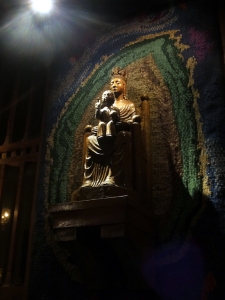
We toured the ancient crypt beneath the Cathedral, where this Black Madonna is found. Parts of the crypt pre-date the Christian era.
Oradour-Sur-Glane
After Chartres, we visited a memorial like no other: the martyred village of Oradour-Sur-Glane, France.

On June 10, 1944, in retaliation for a supposed act of resistance, a German SS officer ordered the slaughter of the entire village.

To honor and memorialize these French citizens, the town was sealed off. It remains exactly as it was left by the Nazi SS troops that day.
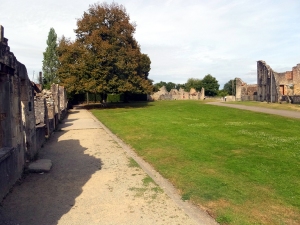
The men of the village were rounded up in the town square, then taken in smaller groups to various sites around the town to be shot dead.

Incendiary devices were set off inside the church. Anyone who tried to escape was killed immediately or forced back inside with machine gun fire. One woman miraculously escaped and lived to tell the story.

The church’s bell, melted and deformed by the intense heat, gives mute testimony to the suffering of the victims.
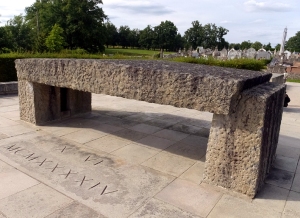
The victims are regarded by the people of France as martyrs to the cause of peace and freedom everywhere. The Roman numerals here spell “10 June, 1944.” This was four days after the D-Day landings. In less than a year, Germany surrendered and the coward Hitler committed suicide.
We, like many Americans, had never heard of this incident, or this site, before planning this trip. A visit to Oradour-Sur-Glane is an emotional and unforgettable experience. If you ever get to France, this is not to be missed.
Dordogne and surrounds
Oradour-Sur-Glane was a mid-day stop on our way to the Dordogne region of France. This mountainous area is the location of many prehistoric caves and artifacts.
Sarlat-la-Caneda

Our destination was Sarlat-la-Caneda, a well-preserved medieval town. We were among the hordes of tourists who visit here.
Sarlat was our base for exploring the prehistoric sites and museums.

Lascaux, perhaps the most iconic of the Dordogne’s prehistoric caves, is no longer open to the public due to deterioration caused by visitors. Lascaux II is an exact replica built nearby. This photo shows some of the astonishing cave art, precisely reproduced so visitors can experience it. (A few other caves in the region with original cave art still allow an extremely limited number of visitors each day.)
The National Museum of Pre-history in Les Eyzies-de-Tayac gives an outstanding overview of the caves and actual artifacts from them. They also have remarkable re-creations. This man is a life-sized figure. Visitors encounter him sitting on a bench in the museum, studying the exhibits.
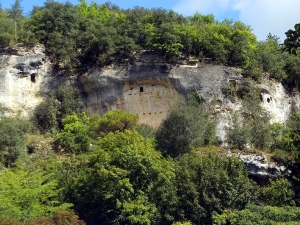
The Dordogne is littered with prehistoric sites. This picture shows the remains of troglodyte dwellings carved into the cliff side.
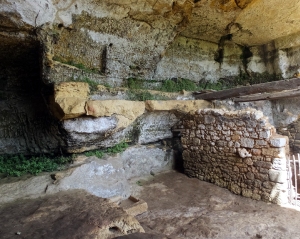
Inhabitants took advantage of natural caves and malleable stone to create homes that were practical and defensible.

Over the centuries, successive generations occupied and developed the site as building technologies advanced.
Rocamadour is an amazing site near the Dordogne. It is a complex of chapels and a Benedictine abbey, first built in the 12th century.

Visitors can climb down from the top of the cliff or up from below. We walked down from the top and took the inclined elevator back up to the car.

Inside one of the chapels is another Black Madonna, an object of veneration by many devout Christians of Europe. This black virgin has been dated to the 12th century, and is believed to have been carved by the Christian hermit St. Amadour.

Toulouse-Lautrec was under-appreciated as a serious artist in his lifetime. He is most famous now for his posters and illustrations. Photography is not allowed in this museum, but I was able to sneak a couple.

The museum is housed in the Palais de la Berbie, after a huge bequest from the Count and Countess of Toulouse-Lautrec, the artist’s parents. This beautiful formal garden is located on the grounds.
Cap D’Agde
The Mediterranean Sea was calling us. Some beach time seemed just the thing, so we headed for the seaside resort of Cap D’Agde. This will be our last stop on this blog post.

The town features a wide and long boardwalk along the marina. It is the center of activity day and night.

The town features one quirky sculpture: A large, fanciful representation of the novelist and playwright Honore de Balzac, donated by the people of Russia. Balzac spent his early childhood in the region.
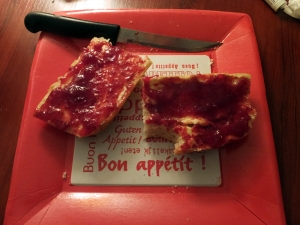
Despite the proximity of so many eateries, we usually ate in the room to save money, as we are doing this whole trip.



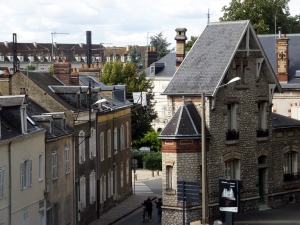

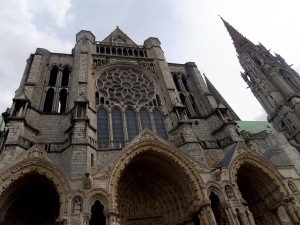
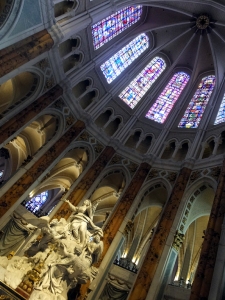

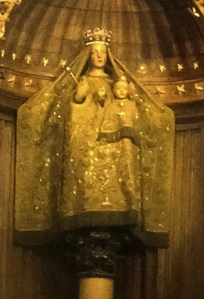




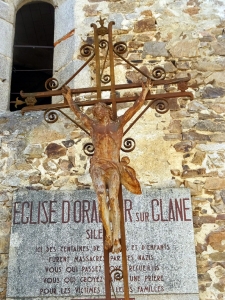


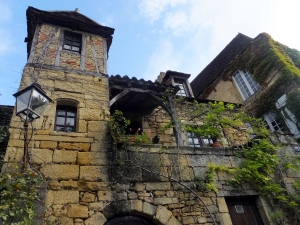
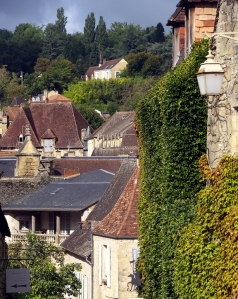

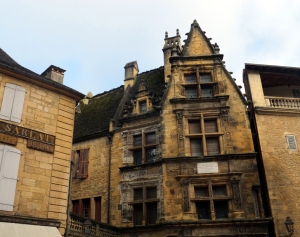
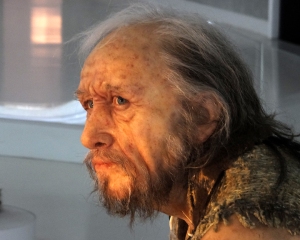





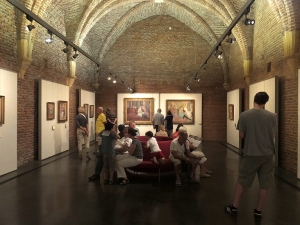



En chantez
LikeLike
You must be enchanted yourself, in Africa! 🙂 C & S
LikeLike
Nice photos! Y’all look fabulous, exactly the type of American travelers we need to counter the stereotype of the ugly Americans…
LikeLike
Thanks Calvin! We’re trying to behave. 🙂 C & S
LikeLike
Charlie, you really are an artist with your camera and your descriptions. And such a poignant reporting on Oradour-Sur-Glane.
LikeLike
Thank you Maria. Sarah sends her love. Me too. Charlie
LikeLike
Thanks for sharing, Charlie! The pictures from that village is so moving. So unbelievable…
LikeLike
Hi Melissa. Yes, it was a sobering experience. I had tears in my eyes.
LikeLike
Your pictures/commentary so brillian I feel like I am tasting FRANCE (still pronouncing like a conehead from SNL) too!
LikeLike
Hi Blue! Thanks for the high praise! Nice to know you are along for the ride. C & S
LikeLike